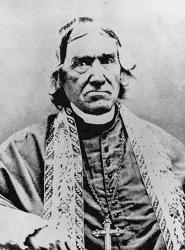Go Ad-Free
If you regularly use Hymnary.org, you might benefit from eliminating ads. Consider buying a subscription.

| Short Name: | Frederic Baraga |
| Full Name: | Baraga, Frederic, 1797-1868 |
| Birth Year: | 1797 |
| Death Year: | 1868 |
Frederic Baraga was born in 1797 in the Austrian territory of Carniola, later known as Slovenia. He was well-educated; he knew several languages, and he graduated with a law degree from the University of Vienna in 1821. He did not practice law, however. Instead, shortly after graduating, he entered the diocesan seminary at Laibach, and in 1823 he was ordained as a diocesan priest. He functioned as a parish priest in the Diocese of Ljubljana for about seven years, and he published a Slovenian prayerbook.
Baraga happened to come upon a pamphlet written by the Vicar General of the Diocese of Cincinnati, Frederick Rése, who was in Europe at the time, setting up a foundation called the Leopoldine Stiftung (Leopoldine Society), sponsored by Emperor Leopold, to supply funding and personnel for Catholic missions in North America. Baraga was impressed by Rése’s booklet, which told of the sad spiritual state of Indians in the Northwest Territories because of the lack of Catholic priests. Baraga requested permission from his bishop to become a missionary to the Indian people in America. He then approached the Leopoldine Society in Vienna, and he became the first missionary that the society sent to America.
Baraga arrived in the United States in January of 1831. He spent several months in Cincinnati, and while there he began to work on learning the Odawa language, helped by a young seminarian, William Maccatebinessi (Blackbird), who was from the Odawa community of Arbre Croche at the northwest corner of lower Michigan. A few months later, Baraga established a mission at Arbre Croche, where he remained until 1833. While there he published an Odawa prayerbook, which included a section of hymns.
The general content of Baraga’s hymnal was already set in his 1832 Odawa prayerbook. In 1837, the first edition of his Ojibwe prayerbook, Baraga included the same hymns, converted to Ojibwe, plus an additional six hymns. In 1843, Baraga published Gete Dibadjimowin, which is a collection of Bible stories, and in an appendix to this work he included a dozen new hymns, which were then incorporated into the hymnal section of the next edition of his prayerbook in 1846. The hymnal continued to grow as a few more hymns were added to each edition of the prayerbook, until it reached a little over one hundred hymns. Baraga's Ojibwe hymns are collaborative works (by his own admission), as he received a lot of help from Ojibwe-speaking natives and mixed-blood people (Métis) in the Lake Superior region.
Baraga later moved to Grand River (now Grand Rapids MI), where there was an Odawa community, and in 1835 he moved to Ojiwe country—to LaPointe on what is now known as Madeline Island in Chequamegon Bay of Lake Superior (now in Wisconsin, but then Michigan Territory). He stayed there until 1843, when he moved to the next peninsula to the east in Lake Superior, to L’Anse, although he continued to visit LaPointe as well as Ojibwe communities west of there in present-day Wisconsin and Minnesota. Ten years later, in 1853, he became the first bishop of upper-Michigan. The bishops of lower Michigan, of Milwaukee, Wisconsin, and of Hamilton, Ontario also ceded to Baraga the responsibility for the Indian missions in their dioceses, so his authority extended all the way around Lake Superior, east from there along the northern side of Lake Huron, and south into Lower Michigan. Baraga was bishop of Northern Michigan until his death in 1868.
Lawrence T. Martin, Ph.D. (Lac Courte Oreilles Ojibwe) Professor Emeritus of American Indian Studies, University of Wisconsin, Eau Claire
| No Hymnals by Frederic Baraga |
|---|
| No hymnals are associated with this person. |